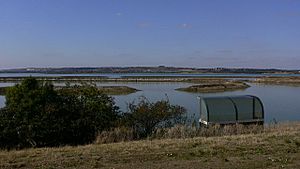West Hayling facts for kids
Quick facts for kids West Hayling |
|
|---|---|
 |
|
| Type | Local Nature Reserve |
| Location | Hayling Island, Hampshire |
| OS grid | SU 713 034 |
| Area | 76.2 hectares (188 acres) |
| Managed by | Havant Borough Council and the Royal Society for the Protection of Birds |
West Hayling is a really special natural area on Hayling Island in Hampshire, England. It's known as a Local Nature Reserve, which means it's a place where nature is protected and people can visit to enjoy the outdoors. This amazing reserve covers about 76 hectares (that's like 188 football fields!).
It's owned by the local government, Havant Borough Council, and looked after by them along with the Royal Society for the Protection of Birds (RSPB). West Hayling is part of a bigger area called Langstone Harbour, which is super important for wildlife. Because it's so valuable, it has several special titles, like "Site of Special Scientific Interest" and "Special Protection Area." These titles mean it's a really valuable place for wildlife, especially birds and marine life, and it's protected by national and international rules.
Contents
Discover West Hayling Nature Reserve
West Hayling is a fantastic spot for anyone who loves nature, especially birds! It's a key part of the larger Langstone Harbour, which is a big natural harbour on the south coast of England.
A Home for Wildlife
This reserve is incredibly important for many different animals. It has huge areas of mudflats and lagoons. These are like natural wetlands that are covered by water at high tide and exposed at low tide.
Mudflats and Lagoons: A Food Feast
The mudflats and lagoons at West Hayling are full of tiny creatures called marine invertebrates. These are animals without backbones that live in the sea, like worms, snails, and small shellfish. They might not look exciting to us, but they are a super important food source!
Birds: Winter Visitors and Summer Residents
Tens of thousands of birds visit West Hayling every year. Many come here in the winter to escape colder places, while others come to breed and raise their young in the spring and summer. They feast on the marine invertebrates in the mudflats. You can see all sorts of birds here, from wading birds with long legs to ducks and geese. It's a busy place, especially during migration seasons!
Protecting This Special Place
West Hayling has many different protections to keep it safe for wildlife.
Why So Many Special Titles?
- Local Nature Reserve: This means it's a place where nature is protected, and people can visit to learn about and enjoy the environment.
- Site of Special Scientific Interest (SSSI): This is a national title given to the best wildlife and geological sites in the UK. It means the area has special plants, animals, or natural features.
- Special Area of Conservation (SAC): This is an international title for places that protect important habitats and species across Europe.
- Ramsar Site: This is an international title for wetlands that are important for birds and other wildlife. It's named after the city in Iran where the agreement was signed.
- Special Protection Area (SPA): This is another international title for areas that are important for wild birds, especially migratory birds.
All these titles show just how important West Hayling is for nature, both locally and globally.

